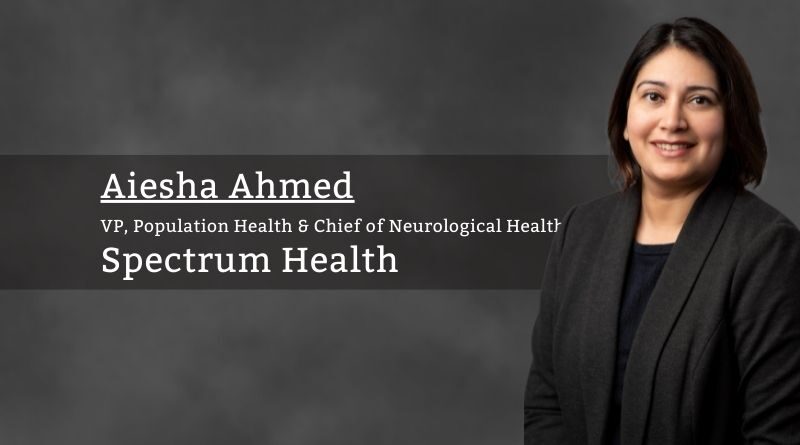Virtual Health Experience aligned with Value-Based Care
By Aiesha Ahmed, VP, Population Health & Chief of Neurological Health – Spectrum Health
The pandemic has catalyzed the care delivery innovations for the healthcare industry. As many healthcare organizations move towards value-based care, the focus has shifted to patient-centered care. One of the ways we are looking at new ways to provide care is to utilize the virtual platform to provide the proper care at the right time and at the right place. We are increasingly recognizing that the right place can often be the patient’s home, where we can remove barriers such as transportation needs, taking time off from work, caregiver presence, etc. Therefore, virtual care is no longer synonymous with ambulatory settings as it can be in the setting of acute care such as tele- ICU, hospital at home, ED settings as well as e-Consult which is an asynchronous interaction between providers to optimize the care of the patient while avoiding fragmentation of care which means moving away from multiple visits with multiple new providers. Concerns that have surfaced include questions such as whether telehealth can continue to remain an option post-pandemic or that only younger patients in the urban location are the ones who prefer the virtual care option. We will have to continue to observe the trends with time and be flexible to pivot by redefining the scope of virtual care. Our data from west Michigan which includes rural settings currently point to positive patient receptiveness to virtual care. Pre-pandemic, our tertiary care healthcare system based in West Michigan conducted 19,053 virtual yearly visits. We saw an increase during the pandemic with 84,883 virtual yearly visits and these have remained stable. Our data also shows that we impacted 329 more zip codes from 2020 onwards than our pre-pandemic geographical footprint in the virtual care arena.
Value-based care requires primary care redesign to allow patients to get most of their healthcare needs fulfilled by the provider who knows them the best.
Our pre-pandemic top five diagnoses for virtual visits were:
- Acute bronchitis, unspecified (ICD-10-CM: J20.9)
- Acute upper respiratory infection, unspecified (ICD-10-CM: J06.9)
- Acute sinusitis, unspecified (ICD-10-CM: J01.90)
- Rash and other nonspecific skin eruption (ICD-10-CM: R21)
- Cough (ICD-10-CM: R05)
And during the pandemic, the top five diagnoses for seeking virtual care are:
- Anxiety disorder, unspecified (ICD-10-CM: F41.9)
- Major depressive disorder, recurrent, moderate (ICD-10-CM: F33.1)
- Essential (primary) hypertension (ICD-10-CM: I10)
- Major depressive disorder, single episode, unspecified (ICD-10-CM: F32.9)
- Acute upper respiratory infection, unspecified (ICD-10-CM: J06.9)
As noted above, mental health disorders have been an area of focus for us. Based on our data, there has been patient receptiveness to accept the telehealth platform for seeking care for behavioral health needs. The need for easy access to common ailments pre-pandemic points to the need to have various options for patients that can meet their needs to get care quickly.
Value-based care requires primary care redesign to allow patients to get most of their healthcare needs fulfilled by the provider who knows them the best. If we continue to explore new ways to meet patient needs, we can avoid fragmentation of care where patients have to seek care from different providers/specialists for different conditions leading to an increase in the cost of care and poor value for the patients. As we continue to refine our offerings within the virtual care setting, one important new addition worth mentioning is our portable all-in-one medical exam kit that enhances the virtual visit experience. During a virtual visit, the mobile medical exam kit links to a patient’s provider, allowing them to capture high-quality sounds from their heart and lungs and share readings of their heart rate and body temperature or create images and videos that show their inner ears, throat, and skin. Their provider then uses this information to make a diagnosis and offer a treatment plan. It has mostly been utilized by primary care but gaining interest by specialty providers too. With the Mobile Exam Kit, patients can get a diagnosis and treatment for many common conditions, including stomach aches, allergies, sinus pain, bug bites, ear infections, pink eye, fevers, rashes, cold and congestion. This allows primary care to help patients in an acute setting and allows avoidance of unnecessary ED/Urgent care visits. In addition, patients need not have to pay more for a virtual visit when using their Mobile Exam Kit. A single kit can also be used for multiple family members. Our experience has been that patients and providers enjoy the enhanced virtual visit capabilities that the mobile medical kit provides. Patients express their appreciation for being able to see the numerous assessments in real time (such as inside their child’s ear, for example) while completing video visits via the kit. Through traditional virtual visits alone, this type of exam was not possible. Providers now can perform exams that were once only possible in an actual exam room. This simple tool allows us to provide care to the patients at the right time and in their home setting. This decreases the unnecessary demand on ED utilization, allowing costs to remain low for patients from a co-pay perspective. We have completed approximately 2,200 visits thus far, averaging around 350 visits per month. Though the percentage of the mobile medical kit vs. traditional visits is low (approximately 5%), we see it increase a percentage point each month or two with continued awareness campaigns.
Similarly, electronic consultations (eConsults) are asynchronous provider-to-provider consultations (between a primary care provider and specialist) that occur within an EHR. We are utilizing eConsults to take advantage of the expertise of our specialists without increasing the demand for specialty care by increasing the referral rate, which leads to long wait times for patients. eConsults provide another ramp onto the telehealth superhighway, to enable specialty practices to explore novel ways of coping with the national shortage of specialists coupled with increased demand for access.
The above have been some ways that have allowed us to leverage virtual health platforms to provide care differently. The virtual health space will continue to grow as we think of new ways to provide care to our patients focused on their convenience while maintaining quality. Outside of acute and chronic disease management, virtual care can be an essential pillar for setting up preventative care models as the healthcare system continues to expand in the population health space.
Acknowledgment (non-author contributors at Spectrum Health): Jared Cowan (Operations Director, Virtual Health), Alexia Eaton (Database specialist, Virtual Health), Michelle Rizor (Principal Strategic Partners, Virtual Health), Dr. Rima Shah (Chief of Primary Health).



